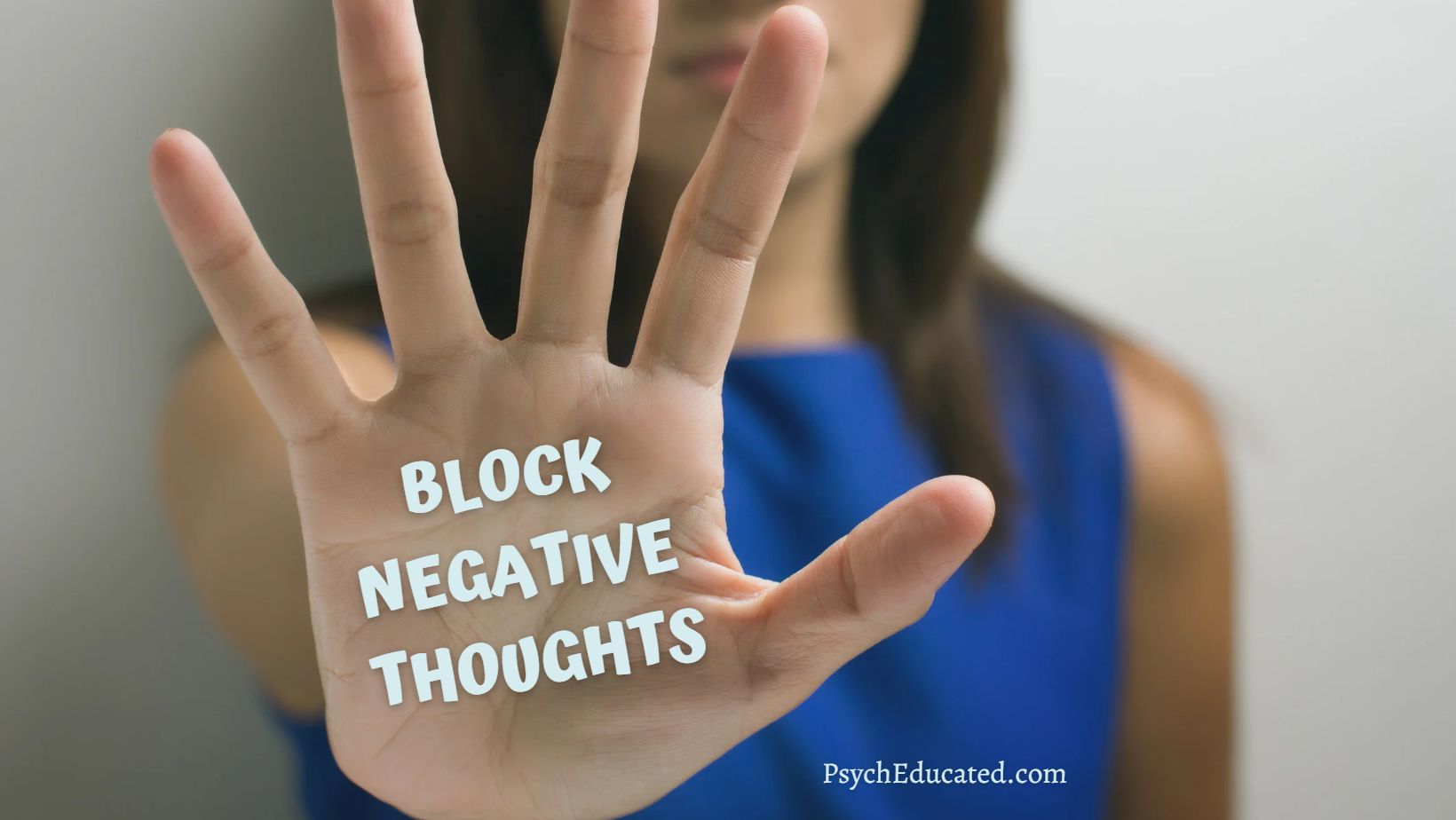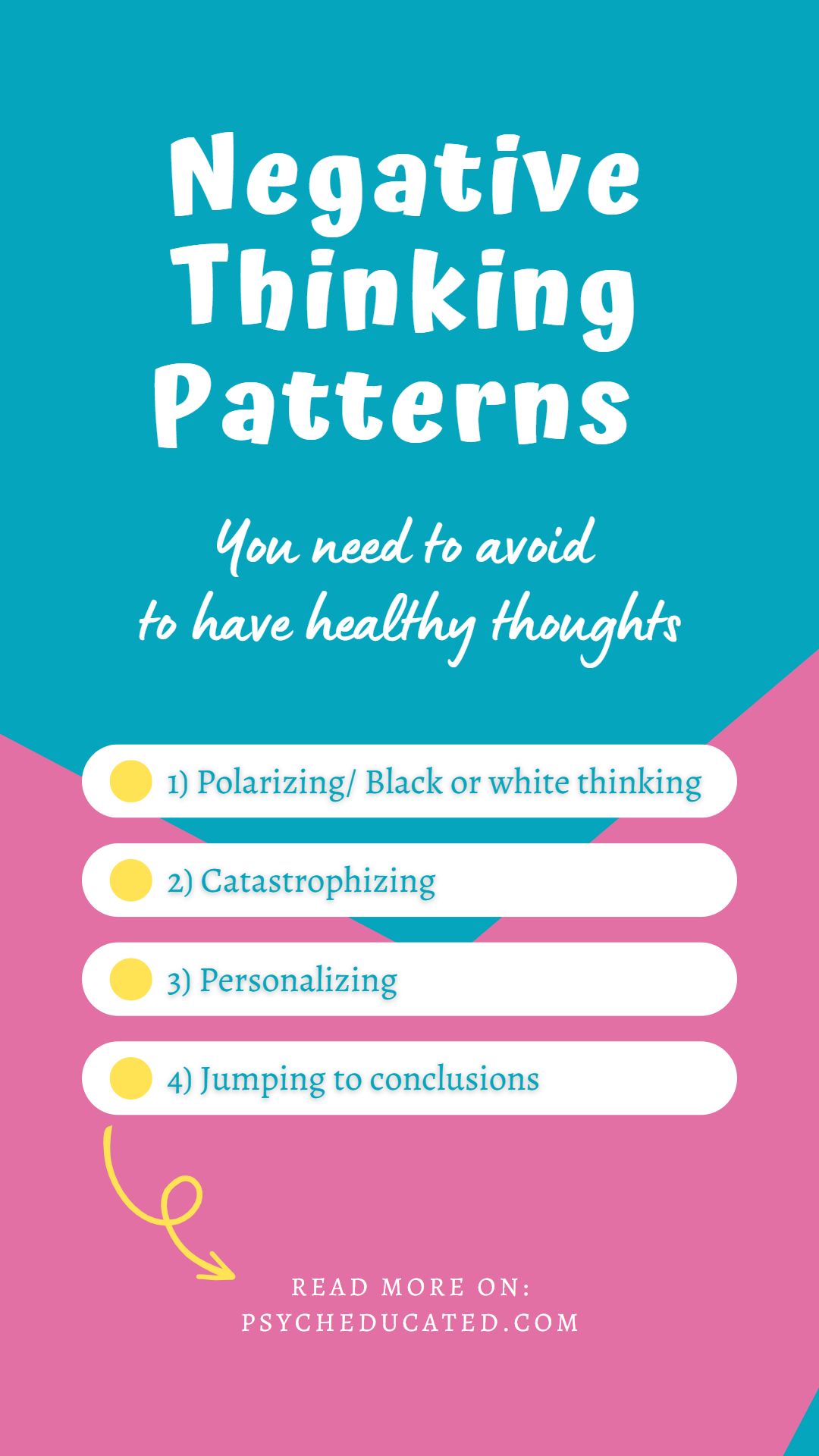Find us on:
How To Block Negative Thoughts: 9 Easy Tips

We all have negative thoughts from time to time. However, when we’re feeling stressed, insecure, or going through depression, blocking those negative thoughts feels like an impossible mission.
Negative thoughts are what stop people most of the time from achieving their goals and developing themselves.
Fortunately, there are practical strategies you can try to block negative thoughts and adopt a positive mindset that will reflect positively on all areas of your life.
But first, let’s take a look at precisely what negative thoughts are.
What are negative thoughts?
Negative thoughts are any thoughts that go into your head that are harmful or hurtful to you in some way. They can make you feel bad about yourself or doubt your abilities.
For example, negative thoughts can sound like this: “I don’t have what it takes to succeed.”; “This is never going to work”; “My coworkers must think I’m an idiot”; and so on.
Negative thoughts can lead to negative emotions such as sadness, anger, or frustration. That’s why it’s important to learn how to block them in order to have a healthier life.
What are the causes of negative thoughts?
It’s important to remember that everyone has negative thoughts from time to time. It’s totally normal.
However, constantly thinking negative thoughts might be a sign of bigger problems.
Mental illnesses like OCD (Obsessive compulsive disorder), GAD (generalized anxiety disorder), and Depression can be the cause of negative thoughts.
Also, childhood trauma, abuse, bad experiences, stress, and anxiety can trigger negative thoughts.
If you’re concerned about your negative thoughts, don’t hesitate to seek the help of a mental health professional.
Negative thinking can also be a very bad habit that has become ingrained in our way of thinking.
This is how you can block negative thoughts
If you’re struggling with negative thoughts, I recommend that you try these strategies and see which one works best for you.
1-Identify your negative thoughts patterns
There are different forms of cognitive distortions that can have an important role in creating negative thoughts.
The negative thinking patterns that result from these distortions can look like this:
Black or white thinking/ Polarizing
With this type of thinking, you only see extremes. It’s either good or bad, a total success or a complete failure. There is no middle ground.
Catastrophizing
Catastrophizing or magnification is when you exaggerate the impact of events and expect the absolute worst to occur without any specific facts. It’s making little concerns look much bigger than they actually are.
Personalizing
Personalizing is when you take things personally.
In other words, when something bad happens, you automatically blame yourself.
Jumping to conclusions
Jumping to conclusions is when you expect negative results before anything happens or when you assume other people think negatively about you.
When you know what pattern of negative thinking you have and become more conscious of the unhealthy cognitive distortion that is messing up your mind, you can label it and call it what it is.
For example, when you catch yourself jumping to conclusions, you stop, acknowledge what you’re doing (“Hey, I’m jumping to conclusions here! “), and remember that it’s simply a thought and not the truth.

2-Replace negative thoughts and beliefs
If you have negative thoughts, try reframing them in a more positive light. For example, instead of thinking, “I’m such a failure,” try thinking, “I’m doing my best, and I will get better with practice.”
To get rid of negative thoughts, you need to replace them first, and this can only be achieved with practice.
You can try daily positive affirmations to help you change the way you think.
[Related article: Powerful affirmations to shift your mindset and achieve goals.]
3-Look for things to be grateful for
Gratitude eliminates negativity, that’s a fact!
When you start having negative thoughts, stop for a second and start listing everything you have that you’re grateful for.
Make a conscious effort to find everything that you love about your life. Appreciate the little things you have, from the clean air you breathe to the more special things that make you unique.
Practicing gratitude can help you change that negative energy that is producing negative thoughts into a positive energy that will make you see everything positive around you.
4-Help someone else
No matter the situation, when you help someone else solve a problem or you just listen to a friend and give them positive feedback, you bring positivity back to your life.
That positive energy that you’ll use to help someone in need of a hand, advice, or a kind word will come back to YOU.
5-Share your thoughts with a good friend
Talking to someone we trust can help us not only vent, but it can also make us realize that our thoughts are not facts.
Make sure you talk to someone who really cares about you and has positive energy because that is contagious and can help you block negative thoughts.
6-Be your own best friend
Talk to yourself as you would talk to a very dear friend.
What would you say to a very close friend who’s having doubts about herself? About her ability to solve a certain problem. That is negatively overthinking a situation.
Well, talk like that to yourself. You must be your own best loving, caring, thoughtful, and compassionate friend.
7-Eliminate sources of negativity from your environment
Duh! If you don’t want to think negatively, you’ve got to stay away from negativity.
Sources of negativity can be people, television, websites, that cracked vase that makes you relive a negative event in your head every time you look at it, and many more.
If watching the news makes your mind go into dark places, stop watching the news!
If it’s that toxic neighbor who comes over every time, pouring down all of their negativity on you, cut them off, and preserve your peace of mind.
No matter what it is, identify the source of negativity and replace it with good company, something with positive vibes, or an uplifting reminder.
8-Do a positivity journal
Every day, feed yourself a little positivity by keeping a daily journal of positive thoughts.
As you have learned to think negative thoughts, this will help you rewire your brain and learn to think positive thoughts.
Think of it as a brain exercise. You can teach yourself to focus on the bright side of things.
You can write about what you’re grateful for. Search for everything positive in your life and write about it.
Every time you think positively, more positivity will come toward you.
Doing this on a daily basis will train your brain to see the positive in everything.
9-Exercise
The relationship between body and mind is extremely powerful, but sometimes it can be very underrated.
People exercise in order to have a better body, to be stronger, and to look better. They want to be fit and have more energy.
But the reality is that if you exercise, you’ll have a bonus that maybe you haven’t thought about: a better, clearer, healthier mind.
It has been scientifically proven that exercising can help with depression, anxiety, and your overall mental health.
That’s why you should incorporate exercise into your daily routine to help you block negative thoughts.
Conclusion
Your mental attitude shapes the way you live your life that’s why you don’t have to let negativity be the main theme up there in your mind.
Remember that your thoughts do not define you. Acknowledge them, process where they’re coming from, and find a positive avenue to let them move on.
Learning how to block negative thoughts and replace them with positive ones is an essential skill for success.
Do you struggle with negative thoughts? are you willing to try some of these strategies? which one? Tell us in the comment section.
Don’t forget to share on social media!
Save this to your Pinterest account!






I LOVE LOVE LOVE you article. I’m a licensed mental health professional working with people who struggle with anxiety and depression. Your article has practical tips and information that are easy to use and I appreciate you sharing them. For anyone struggling with anxiety and looking for tips to treat it naturally check out https://pantearahimian.com/32-simple-ways-to-treat-your-anxiety-naturally/
Thank you. I appreciate it.
I hope this will help someone out there control their negative thoughts.
I try and keep engaged in positive flow, it’s keeps me from negative thinking